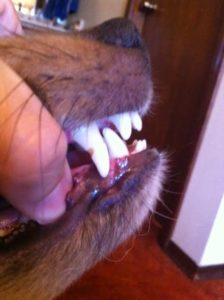Dogs use their teeth the way we use our hands and our teeth. So it make sense they would see a lot of wear and tear. Most dogs, some time in their life, receive damage to a tooth or two. The big question is do you ignore it, go to the vet, or to a specialist?
Tooth Anatomy
As mentioned above, damaged teeth happens a lot in dogs. Especially working dogs like herding breeds who may be biting at sheep or cattle; dogs that play tug hard or catch hard discs; or barrier reactive dogs that bite at their metal crate doors, are at high risk to damage a tooth.
“Fractured teeth are a very common problem for companion animals” says Dr. Kathryn Primm, DVM, owner and practicing veterinarian of Applebrook Animal Hospital.
She explains that dog owners should know the basic anatomy of a tooth, to better know what can happen to their dog’s teeth from every day usage.
The inner chamber of the tooth contains the pulp (blood vessels and nerve tissue). There is dentin (which is a mid-layer) and enamel (the white top layer).
Enamel defects
According to Dr. Primm, these are the less serious of the tooth injuries, involving the surface layers of the tooth:

Enamel defects and chips do not extend into the dentin or pulp, so they are not typically painful.
A veterinary professional may smooth these off without dental surgery, but unless they worsen, they will not cause pain or future problems, other than potentially serve as a place where tartar can attach and build.
Enamel defects are not thought to be painful, but do serve as a rough spot for future tartar to adhere to. Pet owners need to realize the value of dental care including radio-graphs. The image lets us see the tooth crown, root and the bone surrounding it. We can see evidence of bone loss or infectious erosions and give advice on what to do and if we think it is painful or progressive.
So the problem with ignoring, even a small enamel defect, is that it could grow into a bacterial infection in the mouth, which is very dangerous. This will be more likely to happen if you do not brush your dog’s teeth.
Tooth Fractures
Of course, a fractured tooth is immediately painful and a danger to your dog’s health.
Here is the really important part: Fractures that expose the pulp chamber are excruciating even though pets will often act like nothing is wrong. They can serve as a direct highway for infection to enter the blood stream or other organs also. Because the teeth reside on the boney skull, there is no place for swelling to go in a lot of cases and the tooth will just throb. These fractures MUST be addressed, usually with a surgical extraction. Veterinary dentists can, in some cases, do a metal cap on these teeth, but in my general practice, we often extract them because the animal does not care about the beauty of its smile and just wants to not be in pain.
The Bottom Line
Don’t ignore your dog’s teeth. Brushing them, getting routine cleanings, inspecting them yourself, etc., can help you catch problems early on. If your dog’ breaks a back molar, and you never look inside his mouth, he could get a potentially fatal infection before you even realize something is wrong.
So, check your dog’s mouth and if you see something out of the ordinary, or your dog acts like they are in pain, it’s time to go to the vet. Here’s why:
The only way to truly know is to have your vet examine the teeth or tooth. Even a practiced eye can be fooled, so your best bet is dental radiology to be sure how extensive the fracture is. For decades, vets would tell pet owners that there was nothing required to treat these injuries, but thank goodness we know better now.
Dr. Primm adds that the American Board of Veterinary Dentists has a list of members on their website so you can see if there is on in your area.
About the Author
Based in Wilsonville, Ore., animal lover Kristina N. Lotz is a Certified Professional Dog Trainer – Knowledge Assessed (CPDT-KA) and works as a full time trainer. She is the founder of, A Fairytail House, a unique all-positive all-sport dog training facility that helps rescue dogs in her area and provides free seminars and training classes for the community. In her spare time, she trains and competes in herding, agility, obedience, rally, and conformation with her Shetland Sheepdogs. She smartly married a Veterinary Technician, who helps keep the fur kids happy and healthy, and provides a quick resource for articles.
